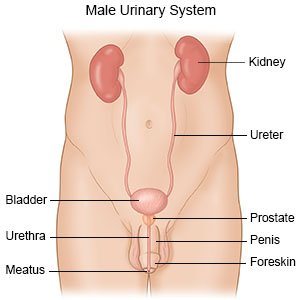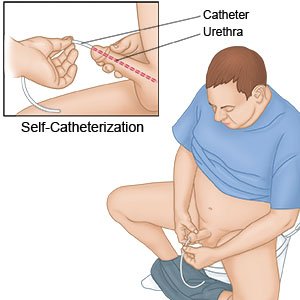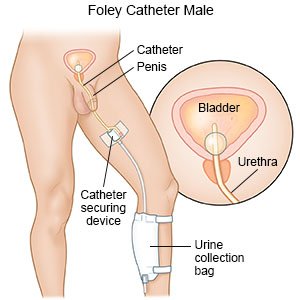Bladder Sling for Men
Medically reviewed by Drugs.com. Last updated on Aug 4, 2025.
A bladder sling procedure is surgery to treat urinary incontinence. The sling acts as a hammock to keep your urethra in place and hold it closed when your bladder is full. The urethra is the tube that moves urine out of your bladder when you urinate. The sling supports your urethra to prevent urine from leaking out.
 |
DISCHARGE INSTRUCTIONS:
Call your local emergency number (911 in the US) if:
- You have sudden trouble breathing.
Seek care immediately if:
- Your leg feels warm, tender, and painful. It may look swollen and red.
- You cannot urinate, or you are urinating less than normal for you.
- You feel confused.
Call your doctor or surgeon if:
- You have a fever.
- You do not feel like you are able to empty your bladder completely when you urinate.
- You feel the need to urinate suddenly or more often than before surgery.
- You have burning or stinging when you urinate.
- You see blood in your urine.
- Your skin is itchy, swollen, or you have a rash.
- You have questions or concerns about your condition or care.
Medicines:
You may need any of the following:
- Prescription pain medicine may be given. Ask your healthcare provider how to take this medicine safely. Some prescription pain medicines contain acetaminophen. Do not take other medicines that contain acetaminophen without talking to your healthcare provider. Too much acetaminophen may cause liver damage. Prescription pain medicine may cause constipation. Ask your healthcare provider how to prevent or treat constipation.
- Antibiotics help prevent or treat a bacterial infection.
- Take your medicine as directed. Contact your healthcare provider if you think your medicine is not helping or if you have side effects. Tell your provider if you are allergic to any medicine. Keep a list of the medicines, vitamins, and herbs you take. Include the amounts, and when and why you take them. Bring the list or the pill bottles to follow-up visits. Carry your medicine list with you in case of an emergency.
Self-catheterization:
You may need to put a catheter into your bladder after you urinate to empty any remaining urine. A catheter is a small rubber tube used to drain urine. Healthcare providers will teach you how to put the catheter in safely. This may be needed until you are completely emptying your bladder when you urinate.
 |
Related medications
Foley catheter:
You may have a Foley catheter for a short period of time. The Foley is a tube put into your bladder to drain urine into a bag. Keep the bag below your waist. This will prevent urine from flowing back into your bladder and causing an infection or other problems. Keep the tube free of kinks so the urine will drain properly. Do not pull on the catheter. This can cause pain and bleeding, and may cause the catheter to come out.
 |
Activity:
Do not lift heavy objects for 6 weeks after surgery. Do not have sex for 4 to 6 weeks. Ask your healthcare provider when you can return to work or your usual activities.
Do pelvic muscle exercises:
These are also called Kegel exercises. These exercises help strengthen your pelvic muscles and help prevent urine leakage. Tighten the muscles of your pelvis and hold them tight for 5 seconds. Then relax for 5 seconds. Gradually work up to tightening them for 10 seconds and relaxing for 10 seconds. Do this 3 times each day.
Keep a record
of when you urinate and if you leak any urine. Write down what you were doing when you leaked urine, such as coughing or sneezing. Bring the record to your follow-up visits.
Prevent constipation:
Drink liquids as directed. You may need to drink more water than usual to soften your bowel movements. Eat a variety of healthy foods, especially fruits, vegetables, and other foods high in fiber. You may need to use an over-the-counter bowel movement softener.
 |
Follow up with your doctor or surgeon as directed:
You may need a test to check how much urine remains in your bladder after you urinate. This will help show how the sling is working. Write down your questions so you remember to ask them during your visits.
© Copyright Merative 2025 Information is for End User's use only and may not be sold, redistributed or otherwise used for commercial purposes.
The above information is an educational aid only. It is not intended as medical advice for individual conditions or treatments. Talk to your doctor, nurse or pharmacist before following any medical regimen to see if it is safe and effective for you.
Further information
Always consult your healthcare provider to ensure the information displayed on this page applies to your personal circumstances.
